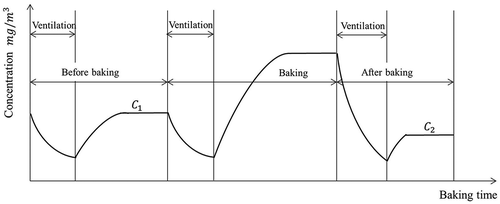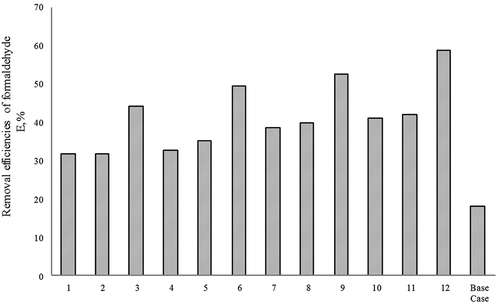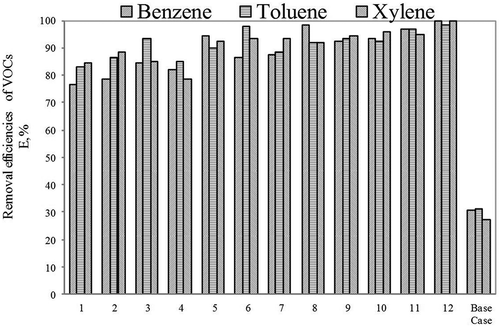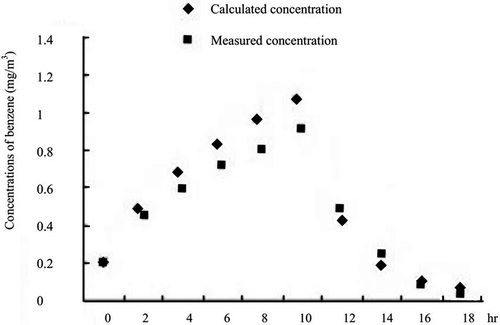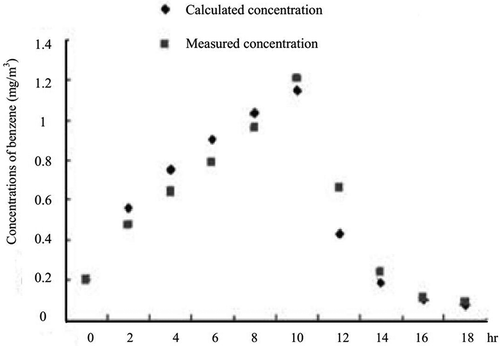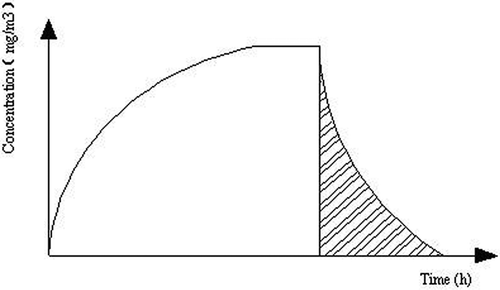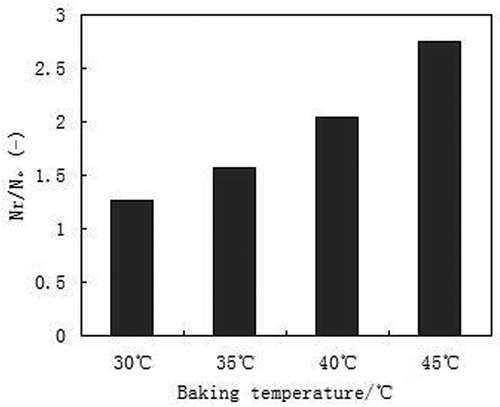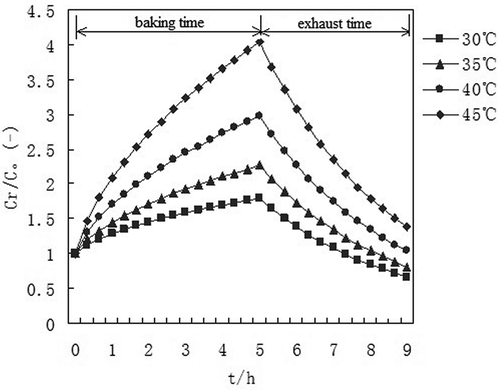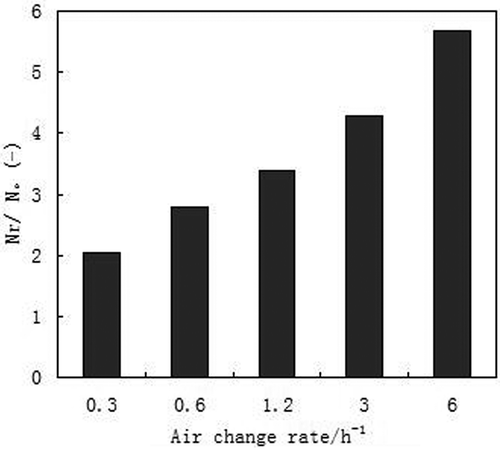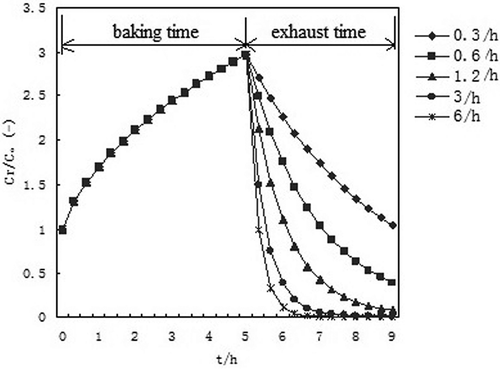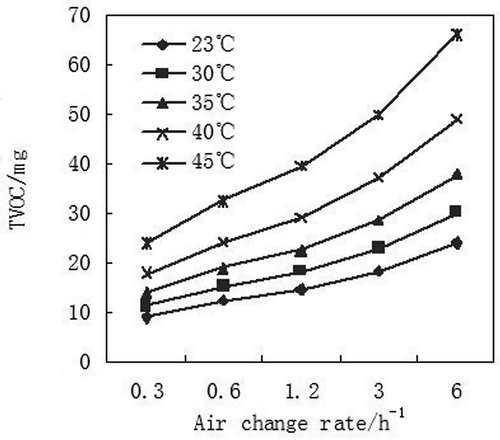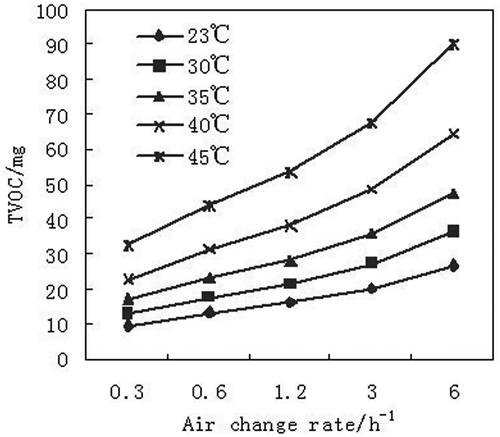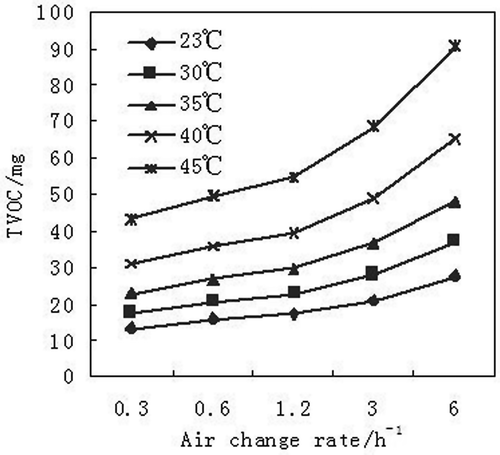ABSTRACT
With recent improvements to living standards and renovations to many residential buildings, a large volume of new building materials have been utilized throughout China. Formaldehyde and other kinds of VOC pollutants, such as benzene, toluene and xylene found in new building materials, however, emit gases that may lead to some direct or potential health problems. Bake-out with dilution ventilation technology has the potential to shorten emission cycles of indoor air pollution, by which off-gassing from building materials can be reduced. In this paper, a test chamber was used to represent a newly renovated residential room in China. Experiments were conducted to study the applicability of the technology for removing of formaldehyde, benzene, toluene and xylene. A numerical method was used to simulate a 1 m3-chamber-TVOC removing amount under different operating conditions and the concentration change of TVOC during the bake-out exhaust dilution process. The effects of bake-out temperatures and times, ventilation times, and air change rates on removal are also discussed.
Implications: VOCs are the main study objective in this paper. With higher baking temperature, longer baking time and longer ventilation time, the removal efficiency is higher in experiment. Removal content of TVOC increases with the increasing number of ACH. With the consideration of energy consumption, it is more reasonable to choose a ventilation time of 4 hours if ACH is 1.2 times/h.
Introduction
Many studies have shown that volatile organic compounds (VOCs) are major air pollutants that can have a substantial impact on human health (Katsoyiannis et al., Citation2008; Edwards et al., Citation2001; Chan et al., Citation2007; Lu et al., Citation2010; Saarela et al., Citation2003; Brinke et al., Citation1998; Choi et al., Citation2009; Zhang et al., Citation2003). Injurants, such as VOCs, contained in building materials are particularly likely to increase the degree of indoor air pollution, resulting in a more evident negative impact on children and females (World Health Organization, Citation2002). With improvements to living standards in China and the ensuing renovations to residential buildings, a large volume of new building and decorating materials have been used, resulting in off-gassing. Some types of VOCs make up the main sources of indoor air pollution and impact people’s health severely, such as formaldehyde, benzene, toluene, and xylene, which are released as emissions from newly installed building and decorating materials. In order to strengthen their regulation, the Chinese government recommended VOC concentration limits (GB/18883-2002 T) in indoor environments in 2002 (see ).
Table 1. Reference standard for indoor air quality in China (GB/18883-2002 T).
Indoor air pollution has been listed as one of the five major environmental pollution factors that pose a significant risk to human health. In accordance with statistics provided by the Chinese Indoor Decoration Union and Indoor Pollution Inspecting Center, 68% of interior decoration materials on the market off-gas toxic air pollutants, and share more than 300 types of VOCs, causing 30 different types of diseases (Wu, Citation2001). In Harbin, there are more than 1500 children receiving cancer treatment at the Harbin Blood Tumor Graduate School. Leucocythemia sufferers account for 80% of them, with most of the children aged approximately 4 years old (Song, Citation2003). Note that the problem with indoor environmental pollution in developing countries is even more critical and can result in even greater damage to human health and economic development. Since the first Indoor Air Quality and Climate International Conference held in 1974, studies regarding effective methods to manage indoor air pollution have become more and more popular. With recurring volatile characteristics of chemical materials contained in building materials, experts have brought forward a bake-out method combined with ventilation, which has received great attention from all over the world, especially the United States, Japan, and Korea (Girman, Citation1989; Hodgson et al., Citation1994; Etkin, Citation1996; Wieslander et al., Citation1997; Yang et al., Citation1998; Kang et al., Citation2010). According to the results of a few pilot studies, total VOC levels decreased by 60–94% in the bake-out process (Kim et al., Citation2005; Van der et al., Citation1997; Offerman et al., Citation1993; Girman Citation1989). Follin et al. found that the bake-out procedure was performed before occupancy and generally anywhere from several days up to 2 weeks (Follin Citation1997; Hicks et al., Citation1990; Kim et al., Citation2010; Lu et al., Citation2010). The principle of this bake-out procedure is to drive the VOCs out of the construction materials into the indoor air by increasing the room’s temperature to 32–40°C, while increasing the outdoor air exchange to remove the emissions from the materials (Kang et al., Citation2006; Lu et al., Citation2012; Kim et al., Citation2010; Li et al., Citation2005; Park et al., Citation2007). Nozaki’s studies showed that formaldehyde and VOC emissions were closely related with temperature (Nozaki et al., Citation2000). Renata Wiglusz’s (Wiglusz et al., Citation2002) research about the effect of temperature on formaldehyde and VOC indicated that emissions are proportional to high temperature. Dingguo Zhou (Zhou et al., Citation1997) also made a relevant study on flake board and obtained the same result. Zhang et al. studied the influence of temperature on formaldehyde emission parameters of dry building materials (Zhang et al., Citation2007).
Bake-out with dilution ventilation technology is advantageous in its embrace of simple theory, high efficiency, and no recontamination, making it one of the most promising technologies in indoor air management, especially when compared to photocatalysis and activated carbon adsorption. Researchers from the United States, Japan, and Korea have already begun work on removing air pollution by the bake-out method (Girman, Citation1989; Hodgson et al., Citation1994; Etkin, Citation1996; Wieslander et al., Citation1997; Nozaki et al., Citation2000; Kim et al., Citation2005). In Korea, actual residential measuring experiments have been conducted, with the aim of assessing the effect of baking. Park found that bake-out can rapidly decrease indoor air pollutant concentration and using natural and mechanical ventilation (opening windows and operating exhaust fans in kitchen and bathrooms) has the highest removal efficiency in comparison to different ventilation strategies (Park et al., Citation2007). Kang analyzed the effect of bake-out on reducing indoor VOC concentrations in a residential housing unit with a radiant floor heating system. They concluded that VOC emissions of the furnishing material were reduced after the baking, and the effectiveness was impacted by the temperature profile of the material (Kang et al., Citation2010).
However, it is quite different in Chinese building types and building materials when compared with those of developed countries. Baking with ventilation technique has been studied in developed countries, but the method is still lacking in relevant research for China. Compared to developed countries, such as Europe and the United States, China has some unique characteristics when it comes to indoor VOC pollution. (1) Whether it is a roughcast house or a hardbound room in the process of renovation, there is a general lack of awareness of indoor air quality impacts on Chinese residents. (2) The emission intensity of pollutants in Chinese building materials, such as particleboard, is even greater than for those produced elsewhere. The variety of particleboards produced in China is made with wood adhesive, which is based on a urea–formaldehyde resin formed by the polymerization of formaldehyde and urea (Tao and Liang, Citation2008; Wang et al., Citation2010). Furthermore, because many decoration companies use unregulated plate or inferior glue when bonding the veneer material as a way to cut costs, this leads to an indoor air quality issue in China that is more dire than in other countries (Qin and Dang, Citation2004). (3) The country’s buildings have, overall, high air tightness for energy conservation coupled with insufficient room ventilation, especially in the winter (Zhu, Hao, and Zhou, Citation2002). Furthermore, radiant floor heating has been widely used in all kinds of buildings in China’s North where extreme cold requires residents to heat their homes, but to do so in an energy-efficient manner (X.M. Yang, Citation2006; M. Li, Citation2009). In these cases, flooring materials can off-gas directly as a result of warm temperatures, which is precisely an important factor influencing formaldehyde and VOC emissions; therefore, bake-out with floor radiation has broad application prospects in China.
Developing special bake-out with dilution ventilation technology is important in order to solve severe indoor air pollution especially in the context of Chinese homes prior to occupancy. The chamber method can be used to evaluate the pollutants released from diverse sources as one of the common testing techniques (Kim et al., Citation2006). This study discusses the effects of bake-out with dilution ventilation technology that are influenced by bake-out temperatures and times, ventilated times, and air change rates (ACHs), based on experimental and numerical methods.
Experiment
Experiment chamber
An experiment chamber was used to simulate a newly decorated room containing noxious gas, comparable to that emitted from off-gassing. Decorating materials were laid out in this chamber according to the practical ratio in the building. The chamber, with a size of 1 m (L) × 1 m (W) ×1 m (H), was made of acrylic glass (), an organic glass polymerized from methyl methacrylate monomer (MMA).
Normal composite floor and plywood were the main materials adopted in this study and were painted three times (with common house paint purchased in store). A 1000-W bulb was used as the heat source and its power was adjustable. Air was supplied from the lower vent into the chamber and exhausted outside by a mechanical fan. There was another fan used to mix the indoor air in the chamber. Chamber air temperature and humidity were measured using a Japan Shinyei THP-B4 temperature–humidity sensor with accuracy of ±0.5°C and ±3.0%.
The air temperature refers to baking temperature, and with the consideration that woodwork may be anamorphic after baking in high temperatures, the temperature was controlled under 45°C within a range of 30°C to 45°C, to ensure no material damage. In foreign baking temperature studies, Kang et al. elevated the floor temperature to 35°C when conducting their residential baking test in Korea, at a continuance of 2 weeks, with little impact on the performance of the material (Kang et al., Citation2010). Van der Wal et al. also pointed out that flooring materials might be heated to 50–60°C with floor heating (Van der Wal et al., Citation1997).
Experiment method
The experiments were carried out according to the diagram shown in . The baking and ventilation times are shown in .
Table 2. Experimental conditions.
During the bake-out experiments, all measurements and data analyses were carried out according to the China Indoor Air Quality Standard (GB/T 18883-2002). A sampling pump was used to obtain samples of formaldehyde and VOCs during the experiment. Formaldehyde, benzene, toluene, and xylene were considered to be the representative indoor air pollutants based on the standard in China. Therefore, these four kinds of pollutants were chosen as the target indoor air pollutants in this study.
For measuring formaldehyde levels, the sampling flow rate and sampling time were 0.5 L/min and 20 min, respectively. Air samples were absorbed in 5 mL redistilled water. The absorption of the sample solution was moved into the volumetric flask to dilution constant volume with water. Afterward, a small amount of diluted solution was extracted into a 25-mL colorimetric tube, and the volume was determined to 10 mL with water. Formaldehyde was detected by an acetyl acetone spectrophometric method using a 752 ultraviolet–visible (UV-Vis) recording spectrophotometer detailed in the Chinese National Standard (GB/T15516) applied to a standard curve (regression: y = 0.0173x – 0.0008, correlation coefficient: 0.9994). VOCs were collected from 10-L air samples with an activated carbon adsorption tube that measured 150 mm long and of 3.5–4.0 mm for the inner diameter. An HP 6890 gas chromatography–flame ionization detection (GC-FID) detailed in a Chinese National Standard (GB11737) was used to detect benzene, toluene, and xylene. The initial temperature was set to 40°C for 2 min, and raised to 80°C at a rate of 5°C/min. The chromatographic column was provided by an Agilent HP-5 capillary column. shows the measurement conditions. The removal efficiency is influenced by many factors, including material type and compound qualities. In this study, both baking temperature and baking time were treated as the affecting factors, employed to discuss the removal efficiency. The removal efficiency is given in eq 1:
where E is the removal efficiency (%), C2 is the formaldehyde and VOC (mg/m3) concentration after baking, and C1 is the initial formaldehyde and VOCs (mg/m3) concentration before baking (C1 and C2 are shown in ).
Experiment results
and show the effect of different baking conditions on formaldehyde, benzene, toluene, and xylene. Removal efficiency of formaldehyde ranges from 31.5% to 58.8% in 12 cases, while the efficiency of the base case is 18.1%. In general, the removal efficiency increases with the increase of the baking temperature and ventilation time. The highest baking effectiveness was found after baking for 10 hr and ventilating for 8 hr at 45°C (case 12). The removal efficiencies of benzene (12 cases ranging from 76.4% to 100%, while the base case is 30.6%), toluene (12 cases ranging from 83.2% to 98.1%, while the base case is 31.3%), and xylene (12 cases ranging from 84.6% to 100%, while the base case is 27.1%), as shown in , all appear to be higher than that of formaldehyde. Thus, it can be seen that the removing effect of VOC is better than that of formaldehyde under the same conditions when applying bake-out exhaust dilution technology. The result is consistent with the research carried out by Nozaki (Nozaki et al., Citation2000).
The main reason for these differences is that large quantities of benzene, toluene, and xylene are contained in water-based coatings and water-based adhesives. These materials always make direct contact with the surrounding air. Therefore, benzene, toluene, and xylene volatilize very easily when temperatures rise, quickly releasing emissions at a rapid decay rate. On the contrary, most formaldehyde originates from water-based treatment agents and solvent-thinned adhesives within building materials, and thus formaldehyde is characterized by a low emission rate and decays slowly.
Numerical simulation analysis
Mathematical model
Although the bake-out effect can be detected by experiments mentioned in the preceding, such studies are costly and time-consuming, where it can be difficult to apply measured data obtained in a small controlled chamber to a real building application. Therefore, it is necessary to develop a mathematical model to predict or estimate the bake-out effect. In this paper, the boundary condition model is based on the following basic assumptions:
1. There exists material internal uniformity and the same initial concentration of pollutants.
2. There is no chemical reaction in the process of the emission of pollutants in the material.
3. The diffusion processes of pollutants in the material do not interfere with each other.
4. The internal material follows one-dimensional diffusion, and concentration differences serve as power transfer, completely obeying Fick’s law.
5. The molecular diffusion effect resulting from temperature difference and electric or magnetic fields can be ignored.
6. The pollutant diffusion coefficient and surface partition coefficient do not change with concentration change.
7. The air and the material interface are always in a state of equilibrium, with dynamic equilibrium becoming quickly established.
8. The pollutant at the bottom of the material does not diffuse through the surface.
According to the preceding assumptions, the material internal VOC emissions model equation is obtained, as established by Yang et al. (eq 2). The model takes into account the VOC diffusion processes inside the material and the effect of the material surface boundary layer on the basis of Fick’s law with simple form and good agreement, mainly used in the single side emission process of VOCs in flat building materials:
where is the instantaneous concentration distribution of VOC in dry conditions material (
);
is time (sec);
is the diffusion and mass transfer coefficient of VOC in dry conditions material, which is a function of temperature (
);
is the diffusion direction that is a vertical plate surface (
);
is the initial concentration of VOC in dry conditions material (
);
is the convective mass transfer coefficient (m/sec);
is the concentration of VOC in material surface at the gas side (
); and
is the concentration of VOC in the ambient air (
).
In this study, only total volatile organic compounds (TVOC) was used as the model pollutant, which is defined as VOCs of the retention time between n-hexane and n-hexadecane by using Tenax GC or Tenax TA to sample and a nonpolar capillary column (the polarity index is less than 10) to analyze. The concentration distribution of TVOC from the indoor materials was calculated using the following simple model shown in eq 3:
The emission rate of TVOC in material surface is obtained by eq 4:
where E(t) is the emission rate of TVOC [mg/(sec-m2)] and L is the thickness of material (in this paper L = 0.006 m).
The source of indoor TVOC consists of two parts: emissions from indoor building materials and transmission from the outdoor environment. The transient TVOC mass balance in the room can be expressed by eq 5:
where Cr is the indoor TVOC concentration (mg/m3), is the outdoor TVOC concentration (mg/m3), Q is the ventilation rate (m3/sec), V is the volume of the room (m3), and M is the emission rate of TVOC (mg/sec), which is given in eq 6:
where A is the area of building material (m2).
The preceding formula supposes the x-axis is vertical to the surface of material and the effective diffusion coefficient is calculated from the Arrhenius equation in eq 7 (Yang et al., Citation1998):
According to the Arrhenius equation, the effective diffusion coefficient has a close relationship with temperature. For eq 7, Dref is the effective diffusion coefficient at 23°C (296 K), T is the absolute temperature (K), and E is an experimental coefficient, equal to 17,200 (K) in this study (Kondo et al., Citation1999).
Model validation
Benzene, toluene, and xylene in volatilized form are the major indoor air pollutants, occupying a large proportion of TVOC (Du et al., Citation2005; Cui, Citation2010). The predicted benzene concentrations based on the model are compared with experimental data (cases 6 and 9). The physical parameters of benzene are: Dref = 1.42 ×10 −10 m2/sec, C0 = 9 ×103 mg/m3 (Liu et al., Citation2007), and L = 0.006 m, A = 1.3 m2. As shown in and (Cases 6 and 9, respectively), the measured value and calculated concentrations are in good agreement. Minor discrepancies may be caused by instability and incomplete mixing of air within the chamber.
Calculation content
The range of measured indoor concentrations of different VOCs is extremely wide. Wang found that TVOC concentrations ranged from 0.213 to 28.326 mg/m3 in Chinese dwellings (Wang, Citation2004). Therefore, the initial TVOC concentration was set at 8.027 mg/m3 for this calculation. In addition, the volume of the room and building materials area was assumed as 1 m3 and 1.3 m2.
With the consideration of the effect of baking time and temperature, ventilation time, and ACH, the index Nr (the removal amount of TVOC) is introduced to estimate the removal effect. This is shown in , where the shaded part represents Nr, which is the removal amount of TVOC. In addition, dimensional removal amounts (Nr/N0) and dimensional concentrations (Cr/C0, C0 = 8.027 mg/m3) are used in this study for the convenience of comparison (Y. Lu et al., Citation2007).
Simulation results
The effect of baking temperature
Because of the different Dc under different temperatures, the baking temperature has a great effect on TVOC emissions. This study determined the basic condition to be ventilation for 4 hr after bake-out for 5 hr with an assumed ACH of 0.3/hr under 23°C. The baking temperature was set at 30, 35, 40, and 45°C, separately. Considering the possible distortion to the woodwork after baking at high temperatures, the baking temperature was controlled, and therefore maintained under 45°C.
shows the dimensionless removal content of TVOC under various baking temperatures. It can be found that the removal contents of TVOC are 1.26, 1.57, 2.04, and 2.75 times under 30, 35, 40, and 45°C when compared with that under 23°C. Thus, it is clear that the removal content of TVOC increases with the increasing of baking temperature. The main reason is that Dc is 3.83, 9.62, 23.48, and 55.7 times more compared with that under 23°C.
shows the dimensionless concentration of TVOC under different baking temperatures. The concentration increases with the increasing of baking temperature and arrives at the peak after 5 hr of baking under 45°C, but decreases to lower than initial concentrations after intermittent ventilation for 4 hr. Thus, it is proven that baking can speed up the process of TVOC offgassing and shorten the emissions period through baking exhaust dilution.
The effect of ACH
It is supposed with 5 hr of baking under 40°C, and ventilation for 4 hr, that the ACH will change to 0.3, 0.6, 1.2, 3, and 6 times/hr. shows the dimensionless removal amount of TVOC under different ACHs. It was found that dimensionless removal amounts of TVOC increase with the increasing of the ACH, and even becomes 3.06 times faster when the ACH goes from 0.3 time/hr to 6 times/hr. shows that 4 hr is sufficient, in that case, and the indoor TVOC concentrations will not change with an ACH increase when the ACH reaches 1.2 times/hr.
Effect of baking and ventilation time
Considering it may do damage to building materials and energy consumption if baking and ventilation times are too long, the following three cases were chosen to study the effect of baking and ventilation times:
Case A: ventilating for 4 hr after baking for 5 hr.
Case B: ventilating for 4 hr after baking for 10 hr.
Case C: ventilating for 8 hr after baking for10 hr.
As shown in , , and , it can be found that the removal amount of TVOC generally increases due to a longer baking and ventilation time. It is therefore clear that longer baking times, higher baking temperatures, and higher ACHs can increase removal content of TVOC more effectively. However, it is not effective to lengthen the ventilation time after ACHs are higher than 1.2 times/hr and baking times are longer than 5 hr.
Study limitations and uncertainties
There are some limitations in the practical application of the bake-out method. The results in this study are based on small-scale experiments, and there would, therefore, be small differences in the actual situations. Real indoor environments, for example, exhibit variations in uniformity of temperature and pollution concentrations, material damages caused by excessive temperature and humidity changes, and the adsorption/desorption in material surface, which are essential factors influencing the bake-out effect (Girman, Citation1989; Tuomainen et al., Citation2001). There is a greater possibility of damaging materials and incurring high costs with increasing bake-out temperatures and periods (Levin, Citation1989). Humidity and moisture content inside the materials may decrease substantially during the baking process, which could result in swelling or shrinking of building materials (Steeman et al., Citation2009). The surfaces of rough and porous materials that initially contain low VOC concentrations could absorb abundant VOCs from indoor air during the baking process, and act as a source when re-emitting these compounds when the baking is finished, causing an increase in concentration of indoor air pollutants (Lee al., Citation2005; Kang et al., Citation2010). In addition, due to the large heat consumption when using the bake-out method, the application of energy-saving technology should be the next research direction.
Conclusion and prospects
This paper discusses bake-out with dilution ventilation technology for building materials based on the combination of a chamber test and numerical simulation for newly decorated rooms in China. VOCs were the main study objective of this paper; the removal content and concentration of TVOC were studied under different bake-out temperatures and times, ventilation times, and ACHs, resulting in the following conclusions:
Whether it is formaldehyde, benzene, toluene, or xylene, higher baking temperatures, longer baking times, and longer ventilation times improves removal efficiency in the experiment. Compared with formaldehyde, the disposing effect of benzene, toluene, and xylene is more evident. The main reason for this is that large quantities of benzene, toluene, and xylene are contained in water-based coatings and water-based adhesives, and so on. Therefore, benzene, toluene, and xylene volatilize very easily with increases in temperature, and their emissions decay rapidly. On the contrary, most formaldehyde originates from water-based treatment agents and solvent-thinned adhesives within building materials, and thus formaldehyde is characterized by a low emission rate and decays slowly.
From numerical analysis, it can be found that the removal content of formaldehyde and VOCs can increase with the increasing of baking temperature, ACH, and baking and ventilation time; these factors, however, play different roles in the process of baking.
With a rise in baking temperature, the removal content of TVOC will also increase, as the effective diffusion coefficient of TVOC is different at different temperatures.
The removal content of TVOC increases with the increasing number of ACHs. With the consideration of energy consumption, it is more reasonable to choose a ventilation time of 4 hr if ACH is 1.2 times/hr.
The removal amount of TVOC increases due to a longer baking and ventilation time. It is not effective to lengthen the ventilation time for more than 4 hr if the ACH is higher than 1.2 times/hr and the baking time is longer than 5 hr.
Funding
This research is supported by the China Environmental Protection Project (201509063), the National Nature Science Foundation of China (51308088, 51578103), and the Dalian Construction Technology Program, the Dalian Science and Technology Fund projects (2014E21SF008).
Additional information
Funding
Notes on contributors
Yang Lv
Yang Lv is an Associate Professor at the Dalian University of Technology.
Jing Liu
Jing Liu is a Professor at the Harbin Institute of Technology.
Shanshan Wei
Shanshan Wei is a graduate student at the Dalian University of Technology.
Haifeng Wang
Haifeng Wang is a graduate student at the Dalian University of Technology.
References
- Brinke, J., S. Selvin, A.T. Hodgson, W.J. Fisk, M.J. Mendell, C.P. Koshland, and J.M. Daisey. 1998. Development of new VOC exposure metrics and their relationship to “sick building syndrome” symptoms. Indoor Air 8:140–52. doi:10.1111/ina.1998.8.issue-3
- Chan, D., C. Tam, and A.P. Jones. 2007. An inter-comparison of VOC types and distribution in different indoor environments in a university campus. Indoor Built Environ. 16:376–82. doi:10.1177/1420326X07081094
- Choi, D.W., K.W. Moon, S.H. Byeon, E.I. Lee, D.G. Sul, and J.H. Lee. 2009. Indoor volatile organic compounds in atopy patients’ houses in South Korea. Indoor Built Environ. 18:144–54.
- Cui, X.L. 2010. Study and application of TVOC content in indoor air by capillary gas chromatography. Qiingdao University, Qiingdao, China.
- Du, R.G., Qi Bing, and H.H. Guo. 2005. Detection of benzene series and TVOC in indoor air. Zhejiang Chem. Eng. 36(8):29–31.
- Edwards, R.D., J.K. Jurvelin, K. Koistinen Saarela, and M. Jantunen. 2001. VOC source identification from personal and residential indoor, outdoor and workplace microenvironment samples in EXPOLIS-Helsinki Finland. Atmos. Environ. 35:4829–41. doi:10.1016/S1352-2310(01)00271-0
- Etkin, D.S. 1996. Volatile organic compounds in indoor environments. Arlington, VA: Cutter Information Corp.
- Follin, T. 1997. Airing out pollutions. Proceedings of the Healthy Buildings/ IAQ’97, vol. 3, Healthy Buildings/IAQ’97, Washington, DC, 3:353–56.
- Girman, J.R., L.E. Alevantis, G.C. Kulasingam, M.X. Petreas, and L.M. Webber. 1989. The bake-out of an office building: A case study. Environ. Int. 15:449–53. doi:10.1016/0160-4120(89)90061-5
- Girman, J.R. 1989. Volatile organic compounds and building bake-out. In Problem building: Building-associated illness and the sick building syndrome, ed. J.E. Cone and M.J. Hodgson, 695–712. Philadelphia, PA: Hanley & Belfus. doi:10.1177/014362448901000305
- Hicks, J., K. Worl, and K. Hall. 1990. Building bake-out during commissioning. Proc Indoor Air 90, Toronto, Canada, 5th International Conference on Indoor Air Quality and Climate 3:413–18.
- Hodgson, M., H. Levin, and P. Wolkoff. 1994. Volatile organic compounds and indoor air. J. Allergy Clin. Immunol. 94:296–303. doi:10.1053/ai.1994.v94.a56008
- Kang, D.H., D.H. Choi, and S.M. Lee. 2010. Effect of bake-out on reducing VOC emissions and concentrations in a residential housing unit with a radiant floor heating system. Building Environ. 45(8):1816–25. doi:10.1016/j.buildenv.2010.02.010
- Kang, D.H., D.H. Choi, S.S. Kim, M.Y. Park, M.S. Yeo, and K.W. Kim. 2006. Ventilation strategies for effective bake-out in new apartment buildings. Healthy Building 4:321–24.
- Katsoyiannis, A., P. Leva, and D. Kotzias. 2008. VOC and carbonyl emissions from carpets: a comparative study using four types of environmental chambers. J. Hazard. Mater. 152:669–76. doi:10.1016/j.jhazmat.2007.07.058
- Kim, S., Y.K. Choi, K.W. Park, and J.T. Kim. 2010. Test methods and reduction of organic pollutant compound emissions from wood-based building and furniture materials. Bioresource Technol. 101:6562–68. doi:10.1016/j.biortech.2010.03.059
- Kim, S., and H.J. Kim. 2005. Comparison of formaldehyde emission from building finishing materials at various temperatures in under heating system; ONDOL. Indoor Air 15(5):317–25. doi:10.1111/ina.2005.15.issue-5
- Kim, S., J.A. Kim, J.Y. An., H.J. Kim, and S.J. Moon. 2006. Development of a test method using a VOC analyzer to measure VOC emission from adhesives for building materials. J. Adhesion Sci. Technol. 20(15):1783–99. doi:10.1163/156856106779024445
- Kim, S.Y., K.Y. Kim, Y.S. Han, and J.W. Koo. 2010. Variation of indoor air quality in a new apartment building by bake-out. Int. J. Environ. Res. 4(2):263–70.
- Kondo, Y., S. Kato, and S. Mulakami. 1999. Physical model and numerical analysis of VOCS emission from building materials (part2) prediction of short term and long term VOCS emission based on micro-macro model. Summaries of Technical Papers of Annual Convention AIJ: 125–126.
- Lee, C.S., F. Haghighat, and W.S. Ghaly. 2005. A study on VOC source and sink behavior in porous building materials–analytical model development and assessment. Indoor Air 15(3):183–96. doi:10.1111/ina.2005.15.issue-3
- Levin, H. 1989. Building materials and indoor air quality. In: Cone, J.E., Hodgson, M.J. (Eds.), Problem Buildings: Building-Associated Illness and the Sick Building Syndrome. Hanley & Belfus, Inc., Philadelphia, PA. 667–69. doi:10.1177/014362448901000305
- Li, J., Y. Liu, Y. Lu, B. Xie, and S. Deng. 2005. Improve of IAQ by a new bake-out method based on chamber tests. 6th Int, Conf. on Indoor Air Quality and Climate, Beijing, China. Indoor Air 3075–79.
- Li, M. 2009. Actuality and development of floor radiation heating system of hot water. Forestry sci. Technol. Inform. 2:72–73.
- Liu, J., J. Li, Y. Lv, and J.R. Zhang. 2007. Study on CFD numerical simulation on technological process of bake out method coupled with intermittent ventilation. J. Environ. Sci. 33(4):67–69.
- Lu, H.X., Q.Y. Cai, S. Wen, Y.G. Chi, S.J. Guo, G.Y. Sheng, J.M. Fu, and A. Katsoyiannis. 2010. Carbonyl compounds and BTEX in the special rooms of hospital in Guangzhou, China. J. Hazard. Mater. 178:673–79.
- Lu, Y., J. Liu, Y. Hiroshi, B.N. Lu, and A.X. Jiang. 2012. Use of Biotechnology coupled with Bake-out Exhaust to Remove Indoor VOC. Indoor and Built Environment. 21(6):741–48. doi:10.1177/1420326X11428342
- Lu, Y., J. Liu, B.N. Lu, A.X. Jiang, J.R. Zhang, B. Xie, J. Li, and L. Zhang. 2007. Numerical value research on bake-out technology with dilution ventilation for building materials. Proc. Building Simulation 2007 907–11.
- Lu, Y., J. Liu, B.N. Lv, A.X. Jiang, and C.L. Wan. 2010. Study on the removal of indoor VOCs using biotechnology. J. Hazard. Mater. 182(1–3):204–9. doi:10.1016/j.jhazmat.2010.06.016
- Nozaki, A., K. Iikura, and S. Yoshizaw. 2000. Effects of bake out as a source control technique for indoor chemical substances (part1). J. Architect. Plan. Environ. Eng. 530:61–66.
- Offerman, F.J., S.A. Loiselle, and G. Arbor. 1993. Indoor contaminant emission rates before and after a building bake-out. Proceedings of the Sixth International Conference on Indoor Air Quality and Climate 6:147–50.
- Park, E.Y., D.H. Kang, D.H. Choi, S.M. Lee, Y.S. Min, J.H. An, M.S. Yeo, and K.W. Kim. 2007. Comparison of ventilation strategies during bake-out in winter at newly built apartment buildings. 6th International Conference on Indoor Air Quality, Ventilation & Energy Conservation in Buildings, Sendai, Japan, October 28–31.
- Qin, J.S., and P.H. Dang. 2004. Indoor environmental pollution hazards. Chongqing Building 4:55–57.
- Shuangxiu Li. 2015. Indoor air quality assessment and purification research. Qingdao University of Science & Technology, Qingdao, China.
- Saarela, K., T. Tirkkonen, J. Laine-Ylijoki, J. Jurvelin, M.J. Nieuwenhuijsen, and M. Jantunen. 2003. Exposure of population and microenvironmental distributions of volatile organic compound concentrations in the EXPOLIS study. Atmos. Environ. 37:5563–75. doi:10.1016/j.atmosenv.2003.09.031
- Song, G.S. 2003. Prevention and Cure Guide of Indoor Environment Pollution. Beijing, China: Mechanical Industry Press.
- Steeman, H.J., M.V. Belleghem, A. Janssens, and M.D. Paepe. 2009. Coupled simulation of heat and moisture transport in air and porous materials for the assessment of moisture related damage. Building Environ. 44:2176e84. doi:10.1016/j.buildenv.2009.03.016
- Tao, G., and C. Liang. 2008. Analysis on development tendency of domestic and global plasticizer market. Plastics Sci. Technol. 36(6):78–81.
- Tuomainen, M., A.L. Pasanen, and A. Tuomainen. 2001. Usefulness of the Finnish classification of indoor climate, construction and finishing materials: Comparison of indoor climate between two new blocks of flats in Finland. Atmos. Environ. 35(2):305–13. doi:10.1016/S1352-2310(00)00157-6
- Van der Wal, J.F., A.W. Hoogeveen, and P. Wouda. 1997. The influence of temperature on the emission of volatile organic compounds from PVC flooring, carpet, and paint. Indoor Air 7(3):215–21. doi:10.1111/ina.1997.7.issue-3
- Wang, K. 2004. Study on Measurement and Estimate and Control of Indoor Pollutants. Ph.D. dissertation, Harbin Inst. Technol, China.
- Wang, L.X., B. Zhao, and C. Liu. 2010. Indoor SVOC pollution in China: A review. Chin. Sci. Bull. 55(15):1469–1478. doi:10.1007/s11434-010-3094-7
- Wieslander, G., D. Norbäck, and C. Edling. 1997. Airway symptoms among house painters in relation to exposure to volatile organic compounds (VOCs)—A longitudinal study. Ann. Occup. Hyg. 41(2):155–66. doi:10.1093/annhyg/41.2.155
- Wiglusz, R., E. Sitko G. Nikel, I. Jarnuszkiewicz, and B. Igielska. 2002. The effect of temperature on the emission of formaldehyde and volatile organic compounds (VOCs) from laminate flooring e case study. Building Environ. 37:41–47. doi:10.1016/S0360-1323(00)00091-3
- World Health Organization. 2002. Department of Protection of the Human Environment, healthy environments for children: Initiating an alliance for action. Geneva, Switzerland: World Health Organization.
- Wu, Q. 2001. Volatile organic compounds pollution. Chem. Teaching 7:17–18.
- Yang, X.D., Q.Y. Chen, and P.M. Bluyssen. 1998. Prediction of short-term and long-term volatile organic compound emissions from SBR bitumen-backed carpet under different temperatures. ASHRAE Trans. 104:1297–308.
- Yang, X.M., and G. Wu. 2006. Present situation and development of low-temperature water floor radiant heating system in China. J. Zhengzhou Univ. Light Ind. Nat. Sci. Ed. 21(4):54–57.
- Yang, S., Q. Chen, and P.M. Bluyssen. 1998. Prediction of short-term and long-term VOC emissions from SBR bitumen-backed carpet under different temperatures. American Society of Heating, Refrigerating and Air-Conditioning Engineers, Inc., Atlanta, GA.
- Zhang, Y., X. Luo, X. Wang, K. Qian, and R. Zhao. 2007. Influence of temperature on formaldehyde emission parameters of dry building materials. Atmos. Environ. 41(15):3203–16. doi:10.1016/j.atmosenv.2006.10.081
- Zhang, Y., and Y. Xu. 2003. Characteristics and correlations of VOC emissions from building materials. Int. J. Heat Mass Transfer 46(25):4877–83. doi:10.1016/S0017-9310(03)00352-1
- Zhou, D.G., and S.G. Han. 1997. Effect of temperature on emission of formaldehyde from flake board. Architecture Manmade Plane 4:3–8.
- Zhu, T., J. Hao, and Z. Zhou. 2002. Present situation, formative causes and countermeasures of indoor air pollution in China. Technol. Equip. Environ. Pollut. Control 3(10):14–18.


